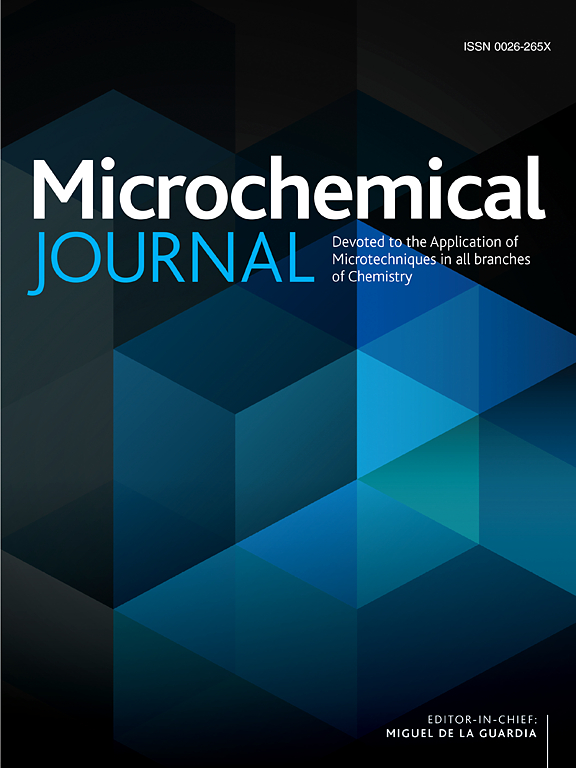基于羧酸酯酶诱导的酰胺键水解的无标记光电化学检测羧酸酯酶活性
IF 4.9
2区 化学
Q1 CHEMISTRY, ANALYTICAL
引用次数: 0
摘要
羧酸酯酶(CE)是一种很有前景的肝细胞癌(HCC)生物标志物,临床诊断需要快速、精确的检测。然而,目前的检测方法受到重大技术挑战的阻碍。本研究提出了一种基于光活性材料之间酰胺键相互作用的新型无标记光电化学(PEC)生物传感器来检测CE活性。我们构建了Cd0.6Zn0.4S/In2O3异质结,优化了带向,实现了光电子-空穴对的高效分离(电子寿命长达0.127 s),显著提高了光电流的产生效率(入射光子-电子转换效率(IPCE)达到15.9%)。在该生物传感系统中,Cd0.6Zn0.4S纳米粒子通过酰胺键交联与In2O3纳米球共价连接。引入CE后,酶解酰胺键导致Cd0.6Zn0.4S从电极表面脱离,导致光阳极信号成比例下降。实验结果表明,在10−5 ~ 0.4 U L−1范围内,光电流响应与CE活性的对数呈线性关系,检测限为3.2 × 10−6 U L−1。此外,所提出的PEC检测平台在检测人血清中CE活性方面表现出高选择性和良好的稳定性,在测定人血清中CE的峰值回收率为94%至102%。这种无标记策略可以通过调节界面电荷传输来灵敏地检测CE,为肝细胞癌的早期诊断提供了一种简化而有效的方法。本文章由计算机程序翻译,如有差异,请以英文原文为准。

Label-free photoelectrochemical detection of carboxylesterase activity based on carboxylesterase-induced amide bond hydrolysis
Carboxylesterase (CE), a promising biomarker for hepatocellular carcinoma (HCC), demands rapid and precise detection for clinical diagnosis. However, current detection methods are hampered by significant technical challenges. This study presents a novel label-free photoelectrochemical (PEC) biosensor based on amide-bond interactions between photoactive materials to detect CE activity. We constructed a Cd0.6Zn0.4S/In2O3 heterojunction with optimized band alignment, which enabled efficient separation of photogenerated electron-hole pairs (electron lifetime as long as 0.127 s) and significantly enhanced photocurrent generation efficiency (incident photon-to-electron conversion efficiency (IPCE) reaching 15.9 %). In this biosensing system, Cd0.6Zn0.4S nanoparticles were covalently linked to In2O3 nanospheres via amide bonds crosslinking. Upon the introduction of CE, enzymatic hydrolysis of the amide bond induced the detachment of Cd0.6Zn0.4S from the electrode surface, leading to a proportional decrease in the photoanodic signal. Experimental results showed that the photocurrent response exhibited a linear relationship with the logarithm of CE activity within the range of 10−5 to 0.4 U L−1, with a detection limit of 3.2 × 10−6 U L−1. Furthermore, the proposed PEC detection platform exhibits high selectivity and good stability for the detection of CE activity in human serum samples, demonstrating a spike recovery of 94 % to 102 % for CE determination in human serum. This label-free strategy enables sensitive detection of CE by modulating interfacial charge transport, providing a simplified yet effective approach for the early diagnosis of hepatocellular carcinoma.
求助全文
通过发布文献求助,成功后即可免费获取论文全文。
去求助
来源期刊

Microchemical Journal
化学-分析化学
CiteScore
8.70
自引率
8.30%
发文量
1131
审稿时长
1.9 months
期刊介绍:
The Microchemical Journal is a peer reviewed journal devoted to all aspects and phases of analytical chemistry and chemical analysis. The Microchemical Journal publishes articles which are at the forefront of modern analytical chemistry and cover innovations in the techniques to the finest possible limits. This includes fundamental aspects, instrumentation, new developments, innovative and novel methods and applications including environmental and clinical field.
Traditional classical analytical methods such as spectrophotometry and titrimetry as well as established instrumentation methods such as flame and graphite furnace atomic absorption spectrometry, gas chromatography, and modified glassy or carbon electrode electrochemical methods will be considered, provided they show significant improvements and novelty compared to the established methods.
 求助内容:
求助内容: 应助结果提醒方式:
应助结果提醒方式:


